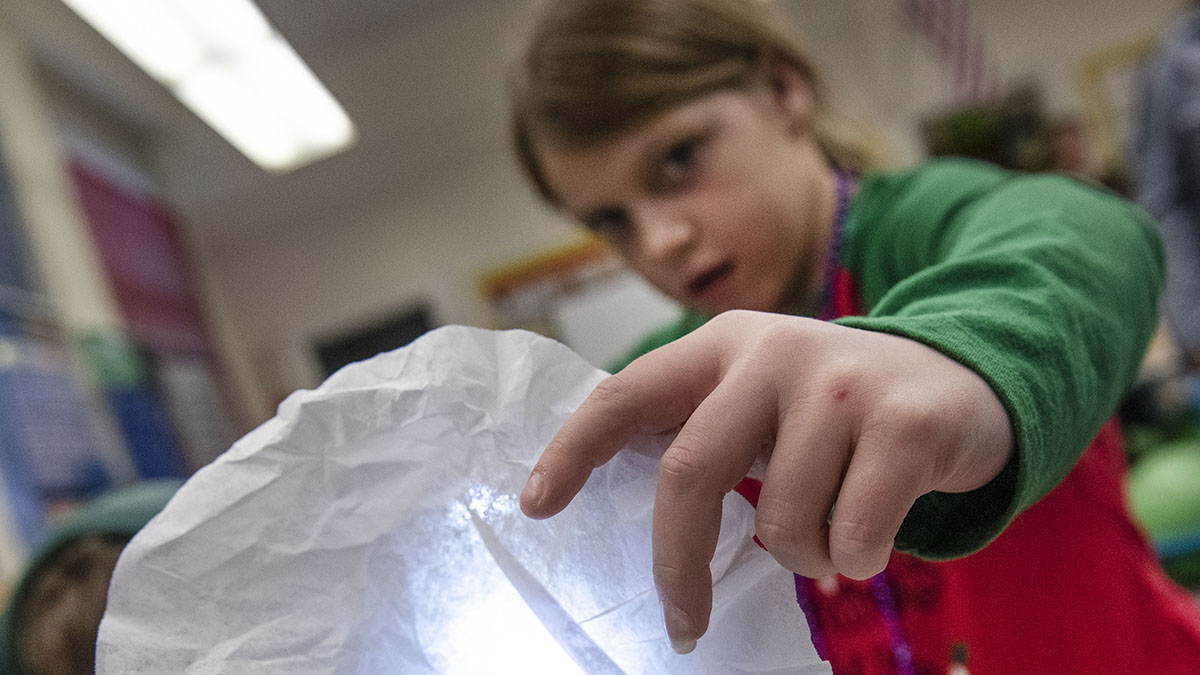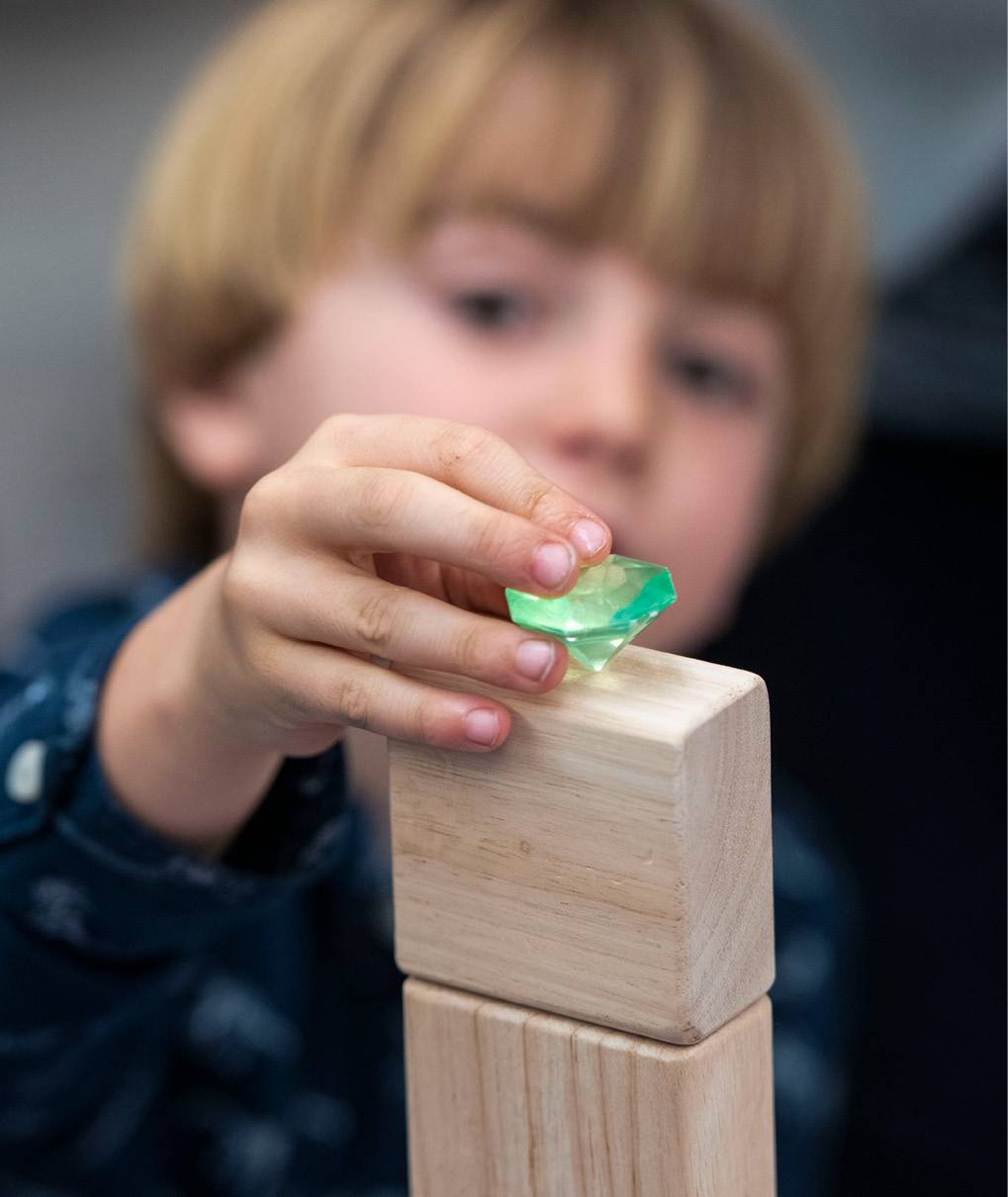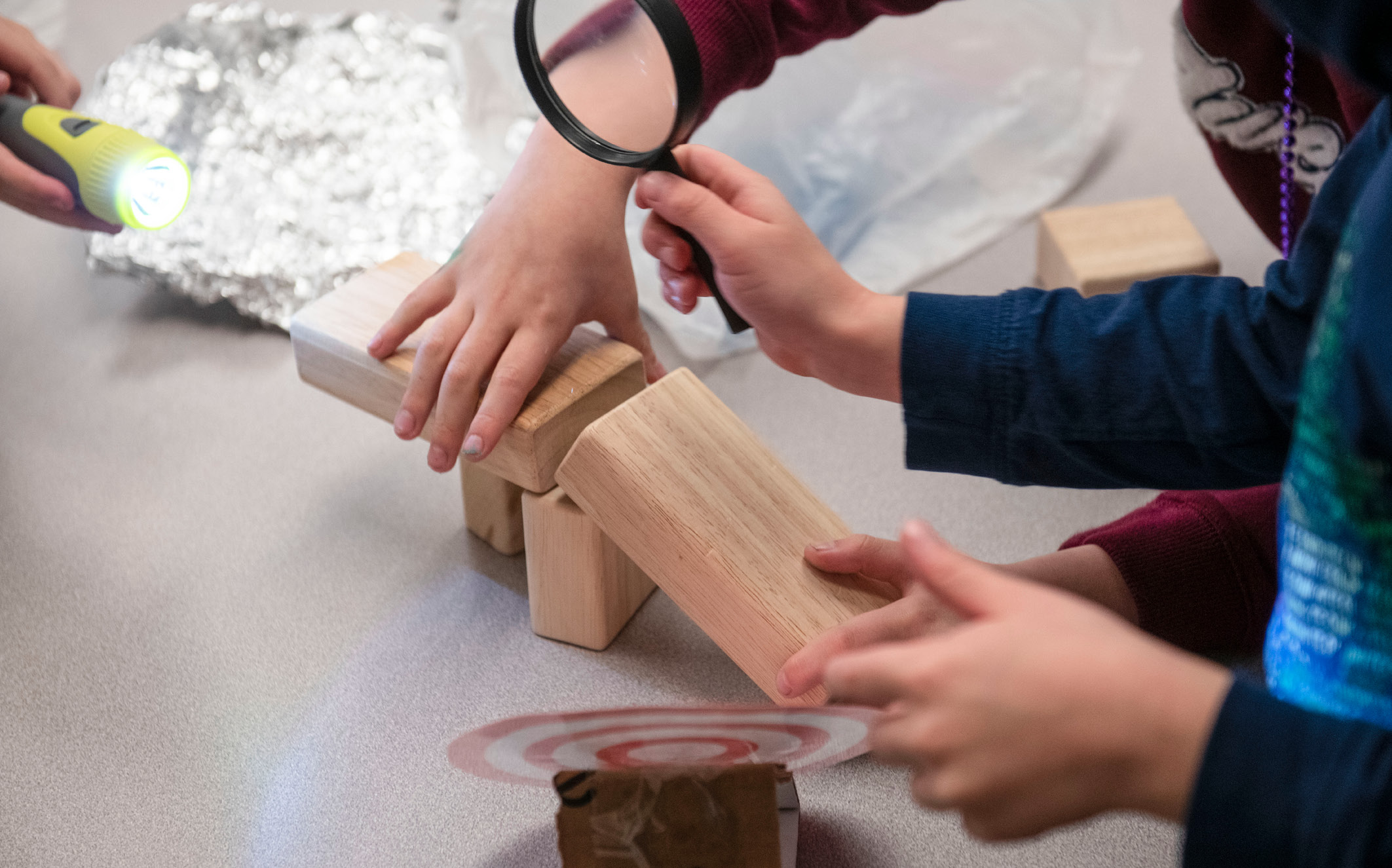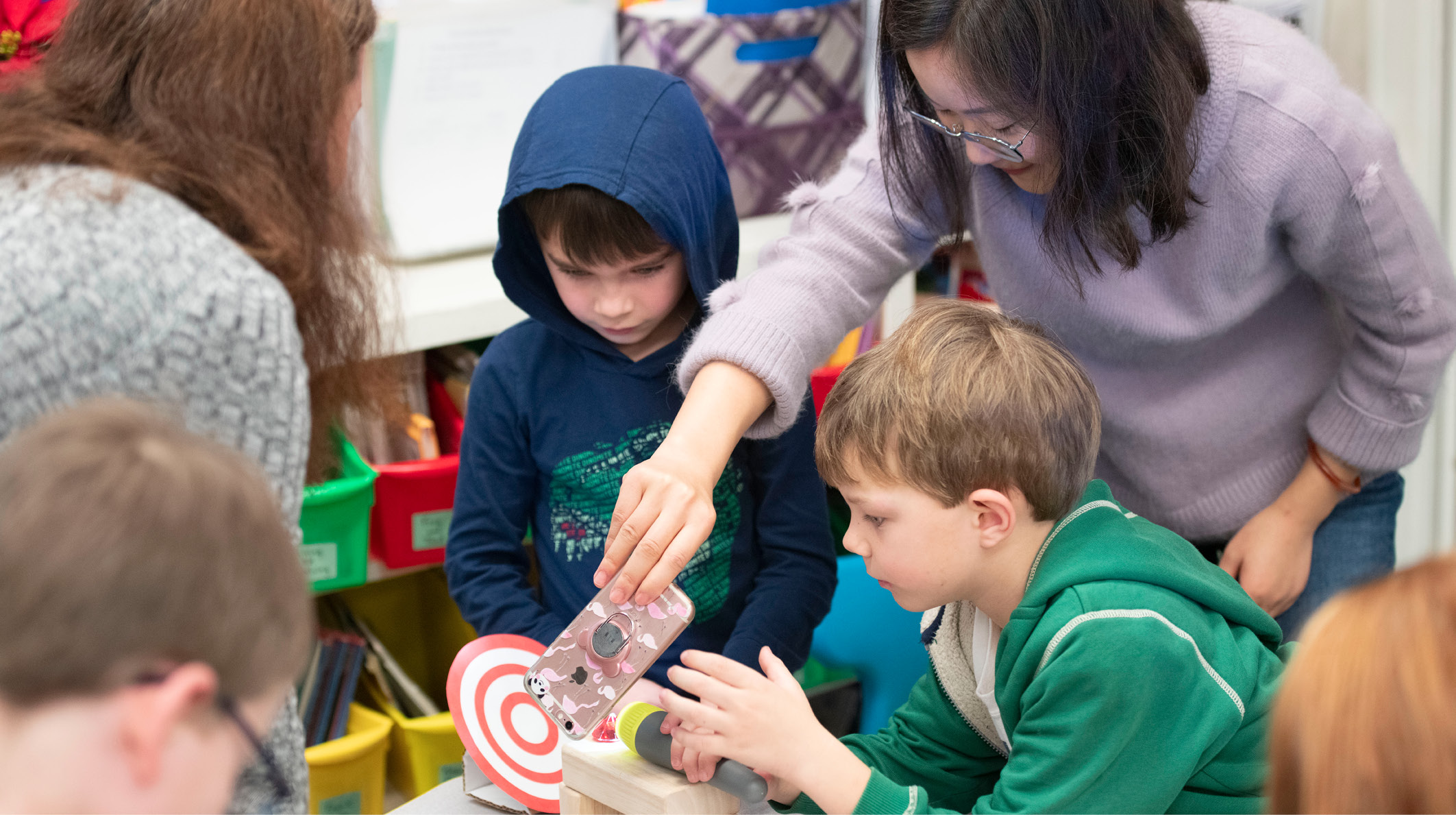Feature
A Light Challenge
First graders engineer an obstacle course with flashlights
Science and Children—January/February 2021 (Volume 58, Issue 3)
By Alissa A. Lange, Erin Rice, Noell Howe, and Qiuju Tian

Social Distancing
After studying the vocabulary for a light unit, teachers could challenge remote learners to find and share household items that are opaque, transparent, and translucent and then use those found items to construct a light obstacle course at home. Someone else in the house could assist by taking photos or video of the student shining a light through the course and uploading the images to share with the class.
If social distancing in the classroom, the students could first design the obstacle course with the teacher during a whole-class discussion. Then, students could take turns being responsible for setting up the components that other students had designed and testing the success of the course. The activity could be revisited once per week or so to allow for cleaning and quarantine of objects between uses.
A group of first graders intently watched a video of a boy leaping over barriers, bouncing off of an angled wall, and darting through hanging structures as he navigated an indoor obstacle course. Students noted how he moved, gasped as he jumped down from a ledge, and clapped as he finished the course. But this was not a lesson on physical education. Viewing this video actually marked the beginning of a science exploration of light. After the video, the teacher asked whether students thought light could move like the boy.
In this class, we wanted to support students’ knowledge of light and the ways in which it interacts with other materials through a series of connected learning experiences. These experiences are related to NGSS standard 1-PS4-3 Waves and Their Applications in Technologies for Information Transfer. Plan and conduct investigations to determine the effect of placing objects made with different materials in the path of a beam of light. We aimed for children to discover that light tends to move in a straight line unless something gets in the way, materials can affect the beam of light, and the way light moves can be impacted by moving the objects.
The connected activities described here were guided by the 5E learning cycle. The students watched the video to spark their curiosity about the path in which something might travel, worked in teams to design and test ideas while exploring the properties of the light, and documented and communicated their observations.
Engage (10–15 minutes)
First, students viewed a short video of a child running through an indoor obstacle course. The purpose of this phase is to “promote curiosity and elicit prior knowledge” (Bybee 2014, p. 12). Children were certainly interested in the way the child moved through the gym. They discussed how he moved, what his body did, and used plenty of positional words (e.g., over, next to). Students used language such as, “he went through those blocks.” We used this video so that students might later use it as inspiration to think of ways to make their own obstacle courses interesting. Students said things like, the boy “…didn’t move in a straight line…,” but rather he bounced off of a wall. (Sure enough, the students did make connections between materials being placed into the light beam when they were later building with the objects the boy encountered as he completed the course: “The boy jumped over blocks, so I want to make the light go over the cat [an opaque object].”)
Explore (30–60 minutes)
We asked students to confront an engineering challenge: design and build an obstacle course in which a beam of light would interact with three objects before hitting a target. We briefly explained the engineering design cycle, and students were placed in small groups of between three and five students with a set of similar materials. We talked with students about how to listen to each other’s ideas during group work. As teachers circled the room, some groups were working more seamlessly than others. Students who were experiencing roadblocks in communication were guided to work together with suggestions such as, “This student has an idea, how can we work together to test it?” Students were placed in small groups of between three and five students with a set of similar materials. The materials were chosen intentionally so that all groups started with some materials that were opaque (wooden blocks, stuffed animal), translucent (sunglasses), transparent (magnifying glass), and reflective (tin foil, pan, mirror). The open-ended nature of the task allowed for differentiation as students approach the problem from various skill levels. Teachers can more specifically support their students such as providing dual language learners with picture vocabulary cards or altering the method for providing directions.

Prisms were a popular item with students.
In the center of the room was a set of additional materials, should children want them, such as prisms, extra blocks, and play dough. In this engineering experience, students first talked about the challenge together and planned what they wanted to build. They then designed prototypes, tested and revised them, and then communicated their findings (Cunningham 2017). For some students, working in groups with just one flashlight and target was challenging, as they had to navigate who would have what role (“I want to hold the flashlight!”). However, we wanted to encourage student communication and cooperation, and with teacher facilitation, all groups were able to be successful.
Almost immediately, groups approached the problem differently. One group decided they needed to find transparent items in order to quickly get the light beam to the target. One student remarked, “we need clear stuff so the light will shine through!” Another group was more focused on making an interesting course and finding ways to move the light like the boy from the video. Students in this group talked about building a challenging course, saying, “Stack the blocks higher!” Another group talked amongst one another and explored how the light interacted with individual materials, before beginning to construct their courses. One student commented on how the light changed color and direction when it shone through a resin gem while another talked about using the magnifying glass to let light pass through it. Another student said, “The pan is shiny.” When students were testing different materials, they talked about their observations. For example, one student asked why a stuffed animal cannot be used. With the teacher’s help, he came up the idea that it is because the light does not go through the stuffed animal and it does not reflect the light. Students had the chance to experience one of the crosscutting concepts (cause and effect). They found out that objects made of different materials have varied effects when placed in the path of a beam of light. Remind students to not shine the flashlight in their or others’ eyes. We talked to children before we began the hands-on portion about how to handle materials safely, such as being careful not to cut fingers with materials like tin foil that had sharp edges, and holding heavy objects like the pan carefully with two hands.
Explain (30–60 minutes)
As students worked, teachers moved around the room and used open-ended questioning to increase engagement and encourage critical thinking. Some of the questions posed included, “Can you move the target?” “Can you include an item that will reflect the light?” We encouraged students who claimed to be finished with the activity to try to make an obstacle course in another way. For example, a group made one obstacle course in which light bounced off objects. Could they make one in which light traveled through an object? Some groups returned to their tables to work on the new challenges. We asked students in these groups to explain to one another how the new course worked, using terms they learned from the prior experience. One student noticed that the shiny objects, like the pan and the tin foil, tended to reflect the light.
Later, students were asked to diagram their course designs and write about how the beam of light traveled to the target. The teachers applied formal terms (e.g., opaque) to the students’ informal words from earlier in the activity (e.g., the light not going through the stuffed animal). As students completed their diagrams, the teachers identified some misconceptions that were not apparent during the Explore phase. One student used an arched arrow to represent the light beam moving over one of the plastic transparent materials, indicating he had not realized light tends to travel in a straight line. This phase of the activity also showed the teachers that some students who appeared to be less engaged in the Explore stage were actually paying attention as their classmates worked more actively with the materials. One such student had detailed diagrams of the group course and was able to explain the phases clearly, even though he did not speak at all during the hands-on component. The evidence obtained through this aspect of the exercise allowed the teachers to design appropriate follow-up activities, including the group activity and the Elaborate activity described below, to further develop student understanding of these concepts.

This "obstacle course" for light included blocks, aluminum foil, a magnifying glass, and a target.
After exploring their materials and designing their courses, students gathered on the rug to discuss their observations with the teacher. Students volunteered to share how they had achieved the goal and the challenges they had faced. As students made observations, the teacher and other students connected the comments to vocabulary. For example, when a student described the light shining easily through the magnifying glass, another student agreed and remarked that the reason is that the glass is transparent. The teacher used this comment to discuss the definition of transparent objects with the group. By conducting the class discussion in this manner, the teacher facilitated meaningful connections between the previous learning and the concepts and vocabulary. Finally, the teacher incorporated informational texts, such as All About Light by Lisa Trumbauer (2004), at the end of this phase. The goal was to build up students’ formal academic vocabulary and to fill in gaps in their understanding of the scientific phenomena related to light.

Teachers stepped in to assist with a phone flashlight.
Elaborate (30–45 minutes)
The next day, students participated in a follow-up activity in their English Language Arts block that allowed them to demonstrate their new understanding of the properties of light by writing an explanatory text to communicate complex information clearly and accurately. Students were prompted to think about how they might explain the strategies they used to move light through the obstacle course to a first grader in another school who had not yet learned about light. The target audience became peers without prior knowledge of the process of moving light through an obstacle course. Students knew that they would need to explain the basic properties of light as well as how they used their knowledge of those properties to make the light hit the target. The teacher left the writing guidelines intentionally open-ended to allow the students to choose how best to communicate their learning. Some students chose to embed the specific academic vocabulary transparent, translucent, opaque, and reflective into their papers and others created a glossary or added illustrations with labels and captions to help their readers visualize the information they were trying to communicate. They employed many of the same helpful and familiar features used in the informational texts they had studied in class.
Evaluate (20–30 minutes)
The teacher evaluated students’ learning by looking for inclusion of factual observations, correct usage of the academic vocabulary, explanation of the learning process, visual displays of understanding, and clarity of expression in their writing samples. Students had the opportunity to evaluate their own learning by exchanging papers with two to four partners and giving feedback to each other regarding the writing guidelines. The following questions were posted to guide the peer responses.
- Did your partner use the words reflective, opaque, transparent, and translucent to describe the objects used in their obstacle course?
- Did your partner explain how we learned about the movement of light?
- Did your partner include a diagram or other visuals to help the reader understand?
- Does your partner’s paper make sense? Would it help someone else understand how light moves through an obstacle course?

Students were captivated by what they could do with a flashlight.
Possible Modifications
We identified aspects of the activity that we might change in the future. A few of the groups misunderstood the challenge and used one item at a time to get light to the target. This misunderstanding actually showed us that it might be beneficial to allow students to simply explore materials with a flashlight before posing the engineering challenge to enhance their prior knowledge. Another variation is to allow students to choose their own materials to use in their structures. Although we had given all groups similar materials to start with to minimize conflict and to ensure all groups started with materials that had all the relevant properties (e.g., that were reflective, transparent, etc.), a more open-ended version might allow students to demonstrate what they know about the characteristics of the materials. In addition, teachers could adapt the Engage portion of this experience to include a challenge for students to travel from one part of the playground to another, in lieu of the video.
During our activity some groups worked more cooperatively than others. Knowing your kids and identifying who works well together can help facilitate a successful collaboration. It may be beneficial to assign jobs within the groups to develop clear roles and expectations. We could differentiate the writing portion for students who found it challenging to spell certain words, like magnifying glass, by using writing sheets that include word banks and sentence starters.
Summary
In this experience, the students were very invested in their engineering challenge. The design of the activity fostered peer interaction as children actively discussed their thinking with peers and demonstrated their understanding of the content (assessment). Students were able to develop their understanding of light energy concepts through their exploration of materials and discussion with peers and teachers. We noticed that one feature of this activity is the potential to serve in more than one phase of the 5E learning cycle, depending on how a teacher approaches the unit. For example, a light obstacle course could be the Engage phase, if the teacher starts with it, before introducing any videos or vocabulary. Overall, this activity illustrated for us that with thoughtfully chosen, everyday materials, we can bring science concepts to life and allow children to shine. ●

Other popular items included materials that were translucent, such as tissue paper and plastic glasses.
Alissa A. Lange (langea@etsu.edu) is an associate professor of early childhood education at East Tennessee State University (ETSU) in Johnson City, Tennessee. Erin Rice (ricee@wataugaschools.org) is a preK teacher in Sugar Grove, North Carolina. Noell Howe (howecn@etsu.edu) is a first-grade teacher at ETSU University School in Johnson City. Qiuju Tian (tianq1@etsu.edu) is a doctoral student in the Early Childhood Education Department at ETSU.
Instructional Materials Physical Science Physics Elementary Grade 1


